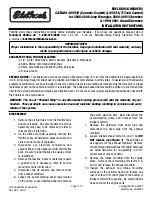
Returning the seat to seating position
Before returning the seatback to its original position, make sure
that cargo or any objects are not trapped underneath the
seatback. After returning the seatback to its original position, pull on
the seatback to ensure that it has fully latched. An unlatched seat may
become dangerous in the event of a sudden stop or collision.
1. Pull control on the side of the seat to release seat cushion from
storage position.
2. Push seat cushion down until it locks into horizontal position.
SAFETY RESTRAINTS
Personal Safety System
姟
The Personal Safety System
娂
provides an improved overall level of
frontal crash protection to front seat occupants and is designed to help
further reduce the risk of airbag-related injuries. The system is able to
analyze different occupant classifications and conditions and crash
severity before activating the appropriate safety devices to help better
protect a range of occupants in a variety of frontal crash situations.
Your vehicle’s Personal Safety System
娂
consists of:
•
Driver and passenger dual-stage airbag supplemental restraints.
•
Front outboard safety belts with pretensioners, energy management
retractors, and safety belt usage sensors.
•
Driver’s seat position sensor.
•
Front crash severity sensor.
•
Front passenger sensing system
•
Passenger Airbag Off indicator light.
•
Restraints Control Module (RCM) with impact and safing sensors.
•
Restraint system warning light and back-up tone.
•
The electrical wiring for the airbags, crash sensor(s), safety belt
pretensioners, front safety belt usage sensors, driver seat position
sensor, and indicator lights.
How does the Personal Safety System
姟
work?
The Personal Safety System
娂
can adapt the deployment strategy of your
vehicle’s safety devices according to crash severity and occupant
2007 F-150
(f12)
Owners Guide (post-2002-fmt)
USA
(fus)
Seating and Safety Restraints
151
















































